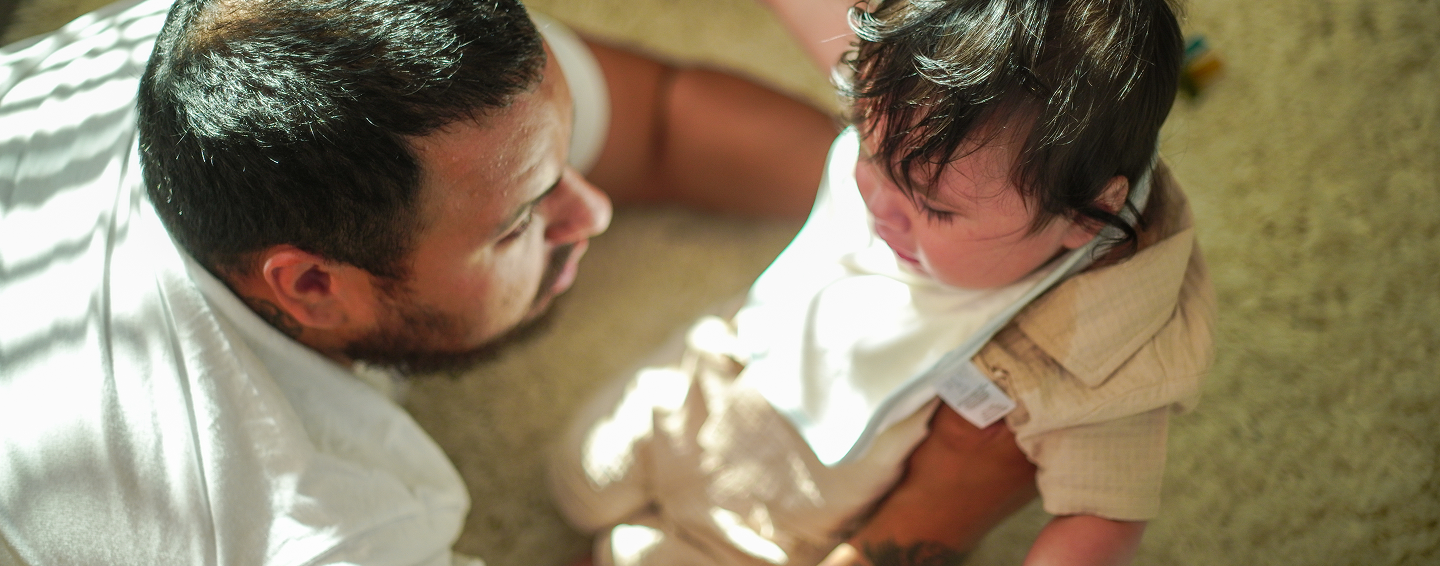Why Sleep-Deprived Parents Are Turning to Technology for Help
A baby sleep trainer device is a specialized tool designed to help infants and toddlers develop better sleep habits through soothing sounds, gentle lights, and consistent bedtime cues. These devices work by creating a calming environment that mimics the womb and supports your baby's natural sleep cycles.
Quick Answer: What Baby Sleep Trainer Devices Do - Sound machines - Play white noise, pink noise, or rhythmic shushing to block distractions - Sleep trainer clocks - Use colored lights to teach toddlers when to stay in bed vs. wake up - Multi-function devices - Combine sounds, nightlights, and smart features in one unit - Portable options - Maintain consistent sleep cues during travel or on-the-go naps
If you're one of the millions of parents struggling with a baby who won't sleep, you're not alone. The research shows that millions of parents worldwide have turned to sleep training devices, with many families reporting significant improvements in their sleep quality.
But do these devices actually work? And more importantly - are they safe?
The truth is, no single product is a magic fix. As one sleep consultant puts it: "Most baby sleep products are marketing gimmicks taking advantage of sleep-deprived parents." However, when used correctly as part of a consistent routine, certain devices can genuinely support your baby's journey to independent sleep.
I'm Gary Harutyunyan, and my journey with baby sleep trainer devices began when my own newborn struggled with sleep despite trying every product and guide available. This experience led me to create the Sleepy Baby, combining my background managing complex projects with the urgent need to help families find rest.
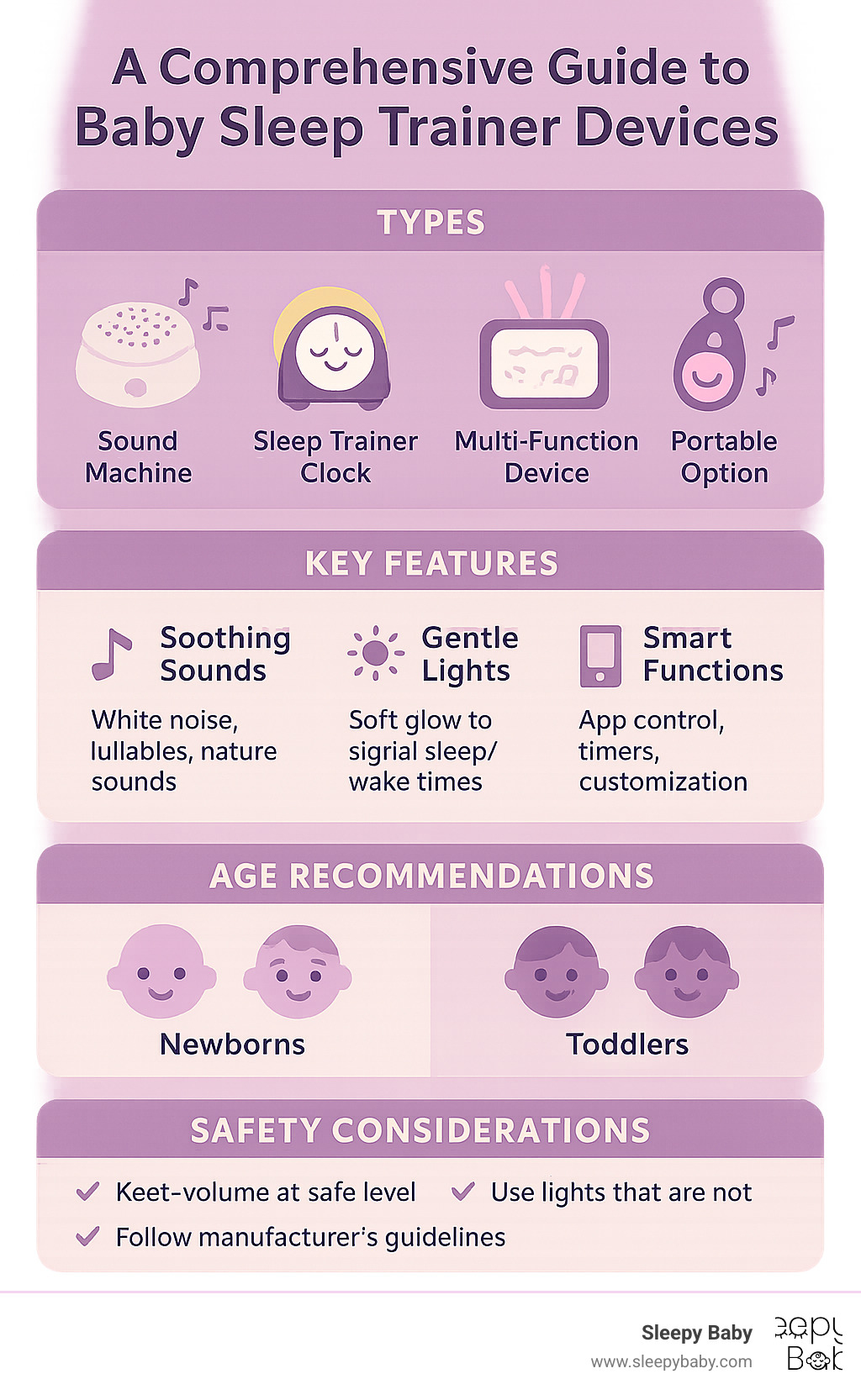
What Is a Baby Sleep Trainer Device and How Does It Work?
Picture this: your baby spent nine months in a surprisingly noisy environment, listening to the constant whooshing of blood flow and muffled sounds from the outside world. That cozy womb was actually about as loud as city traffic - around 85 decibels! Then suddenly, they're born into our relatively quiet homes, and we wonder why they struggle to settle down.
This is where a baby sleep trainer device steps in to bridge that gap. At its core, these devices help establish independent sleep by providing consistent environmental cues that signal it's time to rest. They work by recreating some of those familiar, comforting elements your baby knew before birth.
Think of it as sound conditioning for sleep. Just like how you might feel more relaxed hearing your favorite song, babies learn to associate certain sounds and lights with sleep time. These devices provide circadian cues - signals that help regulate your baby's internal clock - while offering a bit of that womb mimicry that feels so familiar.
Baby Sleep Trainer Device 101
The magic of any baby sleep trainer device lies in how it triggers your baby's natural calming responses. These multisensory aids work by giving babies the consistent sensory input they need to transition from wide-awake to sleepy more easily.
Most devices tap into what sleep experts call neural calming - essentially, they activate your baby's parasympathetic nervous system, which is responsible for that "rest and digest" mode we all need for good sleep.
The beauty is in the consistency. When your baby hears the same soothing sound or sees the same gentle light every time they sleep, their brain starts making the connection: "Oh, this means it's sleep time." It's like creating a sleep playlist that actually works.
Some devices focus purely on sound, others use gentle lights, and many combine multiple sensory inputs for a more comprehensive approach. The key is finding what resonates with your particular baby - some respond better to rhythmic sounds, while others prefer steady white noise or gentle visual cues.
Core Mechanisms
Understanding how these devices actually work helps you make the best choice for your family. Let's break down the main mechanisms:
White noise and pink noise are the heavy hitters in the sound department. White noise contains equal energy across all frequencies - think of that familiar "shhhh" sound that seems to magically calm crying babies. Pink noise has more energy in the lower frequencies, creating sounds more like gentle rainfall or ocean waves. Research shows both can improve infant sleep, with pink noise often feeling less harsh and more naturally soothing.
Red light is the MVP of sleep-friendly lighting. Unlike blue or white light that can interfere with melatonin production, red LED lights allow you to check on your baby or handle nighttime feedings without fully waking them up. It's bright enough to see what you're doing but gentle enough not to signal "morning time" to your baby's brain.
Gentle vibration takes things a step further by adding that tactile element many babies crave. Some devices incorporate rhythmic patterns that mimic a caregiver's comforting touch - think of it as a technological version of patting your baby's back to help them settle. This can be especially helpful for babies who need more sensory input to feel secure and calm.
The science behind all of this is pretty fascinating. When babies hear consistent, rhythmic sounds or feel gentle, repetitive motions, it activates their natural soothing reflexes - the same ones that helped them feel calm and secure in the womb.
Choosing the Best Baby Sleep Trainer Device: Key Features to Compare
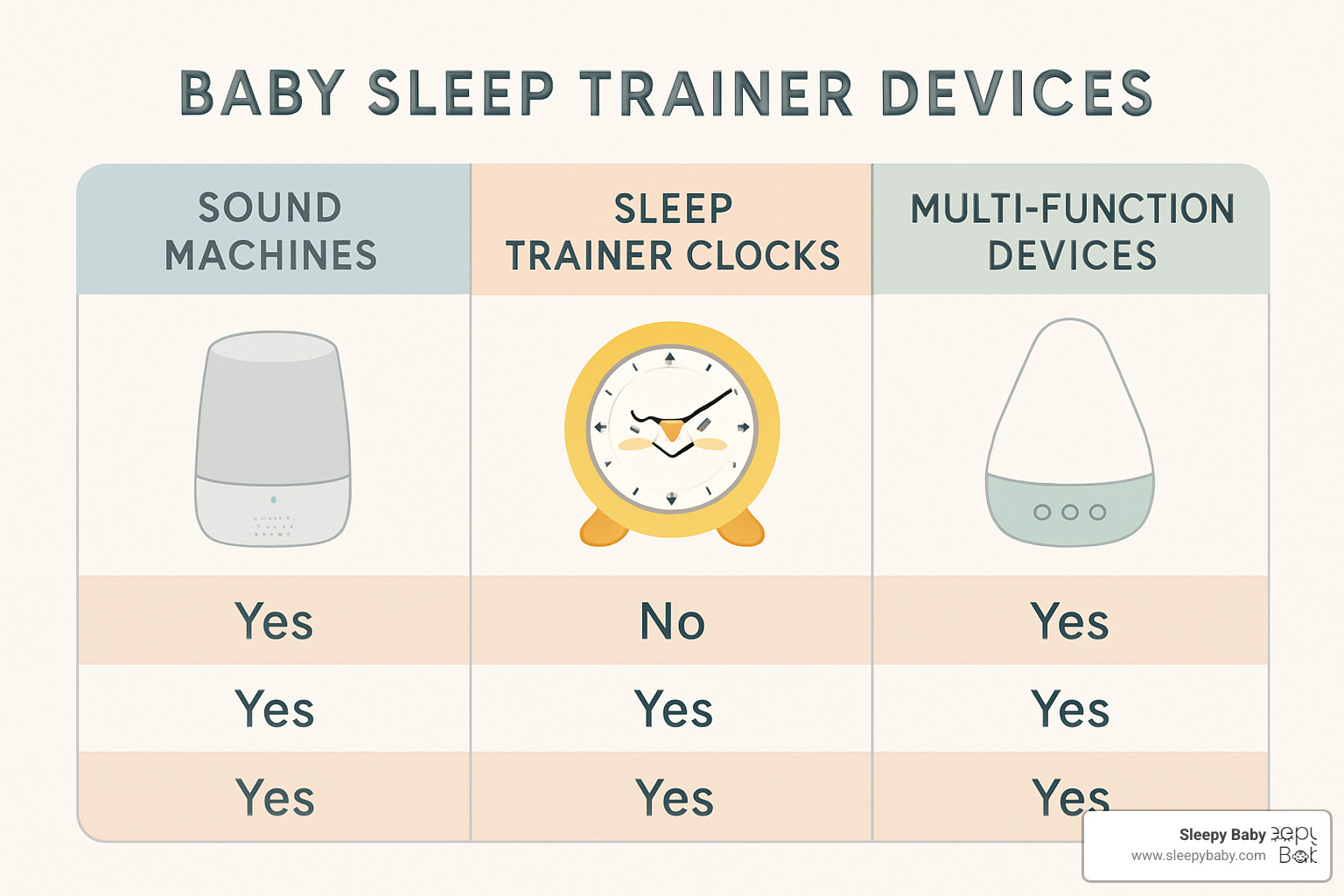
Walking into a baby store or browsing online, you'll quickly find there are dozens of sleep devices promising to be the solution to your sleepless nights. The truth is, not all baby sleep trainer devices are created equal, and what works for your neighbor's baby might not work for yours.
The good news? Once you understand what features actually matter, choosing becomes much simpler. I've seen families waste hundreds of dollars on gadgets that looked impressive but missed the basics, while others found success with simpler devices that got the fundamentals right.
Let me break down what really makes a difference, starting with the three main categories you'll encounter:
| Feature | Sound Machines | Sleep Trainer Clocks | Multi-Function Devices |
|---|---|---|---|
| Primary Age Range | 0-24 months | 18 months-5 years | 0-5 years |
| Portability | High | Low | Medium |
| Battery Life | 8-12 hours | Plug-in only | 6-24 hours |
| App Control | Rare | Common | Very Common |
| Price Range | $25-60 | $50-150 | $80-200 |
| Volume Range | 40-85 dB | 40-70 dB | 40-85 dB |
Sound machines are your classic white noise devices - simple, effective, and perfect for younger babies. They excel at portability and typically offer the longest battery life, making them ideal for families who travel or move between rooms frequently.
Sleep trainer clocks are designed for toddlers who can understand visual cues. These devices use colored lights to teach when it's okay to get up versus stay in bed. Most require plugging into the wall, but they often come with app control for easy adjustments from your phone.
Multi-function devices try to do it all, combining sounds, lights, and smart features. They're versatile but can be more complex to use and typically fall somewhere in the middle for portability and battery performance.
Age & Readiness for a Baby Sleep Trainer Device
Timing matters more than you might think. I've watched parents introduce complex devices too early, only to abandon them in frustration, then successfully use the same device months later when their baby was developmentally ready.
For newborns up to 3 months, keep it simple. Your baby is still adjusting to life outside the womb and benefits most from consistent, gentle sounds. This is when basic sound machines shine - they provide that familiar auditory environment without overwhelming your little one with too many features.
Between 3-6 months is often the sweet spot for introducing a baby sleep trainer device with more features. Your baby's sleep patterns are maturing, and they're beginning to form stronger sleep associations. This developmental milestone makes it an ideal time to add gentle light cues alongside sound.
From 6-18 months, your baby can handle more variety within their routine. Devices with multiple sound options and timer functions become more valuable as sleep needs change and consolidate.
After 18 months, you're entering toddler territory where sleep trainer clocks become game-changers. Toddlers can understand that red means "stay in bed" and green means "time to get up" - turning what used to be early morning battles into independent decision-making.
Must-Have Features in Any Baby Sleep Trainer Device
After working with thousands of families, I've identified the features that consistently make the biggest difference in real-world use. These aren't the flashy extras that grab attention in marketing materials - they're the basics that determine whether a device actually helps or becomes another unused gadget.
True white noise is non-negotiable. Many cheaper devices play short sound loops that restart every 30-60 seconds. These interruptions can actually wake babies rather than soothe them. Scientific research on white noise and infant sleep confirms that continuous, non-repeating sounds are most effective for maintaining sleep.
Dimmable red LED lighting serves a specific purpose beyond just looking pretty. Red wavelengths don't interfere with natural melatonin production the way blue or white light does. This means you can handle nighttime feedings and diaper changes without fully waking your baby or disrupting their sleep hormones.
Auto-shut-off timers give you flexibility as your baby's needs evolve. While some families prefer all-night operation, having options for 30 minutes, 1 hour, or 2 hours allows you to adapt the device to your specific routine and your baby's changing sleep patterns.
Voice recording capability might sound like a nice-to-have feature, but it's often incredibly powerful. Your familiar voice singing a lullaby or offering gentle reassurance can be more effective than any generic sound, especially for babies who are particularly sensitive or going through separation anxiety phases.
Precise volume control isn't just about convenience - it's about safety and effectiveness. The device should maintain consistent volume levels throughout operation and never exceed safe decibel limits, protecting your baby's developing hearing while providing the right amount of sound masking.
Benefits and Limitations: Science-Backed Pros, Real-World Cons
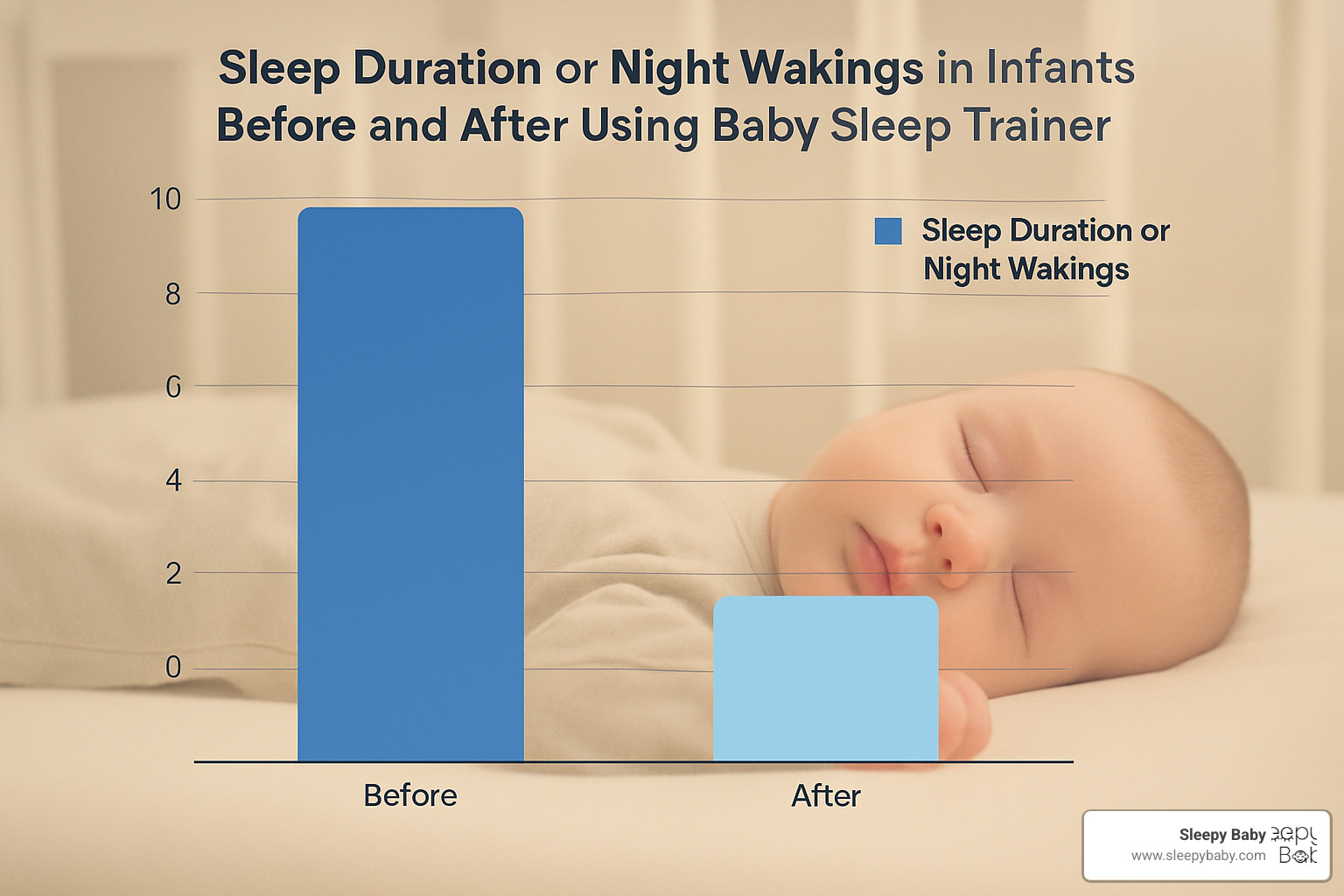
Let's be honest about what a baby sleep trainer device can and can't do for your family. After working with thousands of parents, I've seen both the genuine wins and the disappointing moments when expectations don't match reality.
The research backing these devices is actually quite encouraging. Studies show that babies using white noise machines experience longer sleep bouts and reduced night wakings. One large study following 11,000 children found something particularly interesting - each additional hour of sleep reduced obesity risk later in childhood, highlighting just how important quality sleep is for our little ones.
When parents track their results, the numbers tell a compelling story. Most families report a 20-40% reduction in time to fall asleep once they establish a routine with their device. Early morning wakings - you know, those brutal 5 AM "I'm ready to party!" moments - become significantly less frequent.
The travel-friendly advantages can't be overstated. Whether you're visiting grandparents or staying in a hotel, having those familiar sounds and routines can mean the difference between everyone getting rest and... well, let's just say nobody wants to be that family with the screaming baby in the hotel hallway at 2 AM.
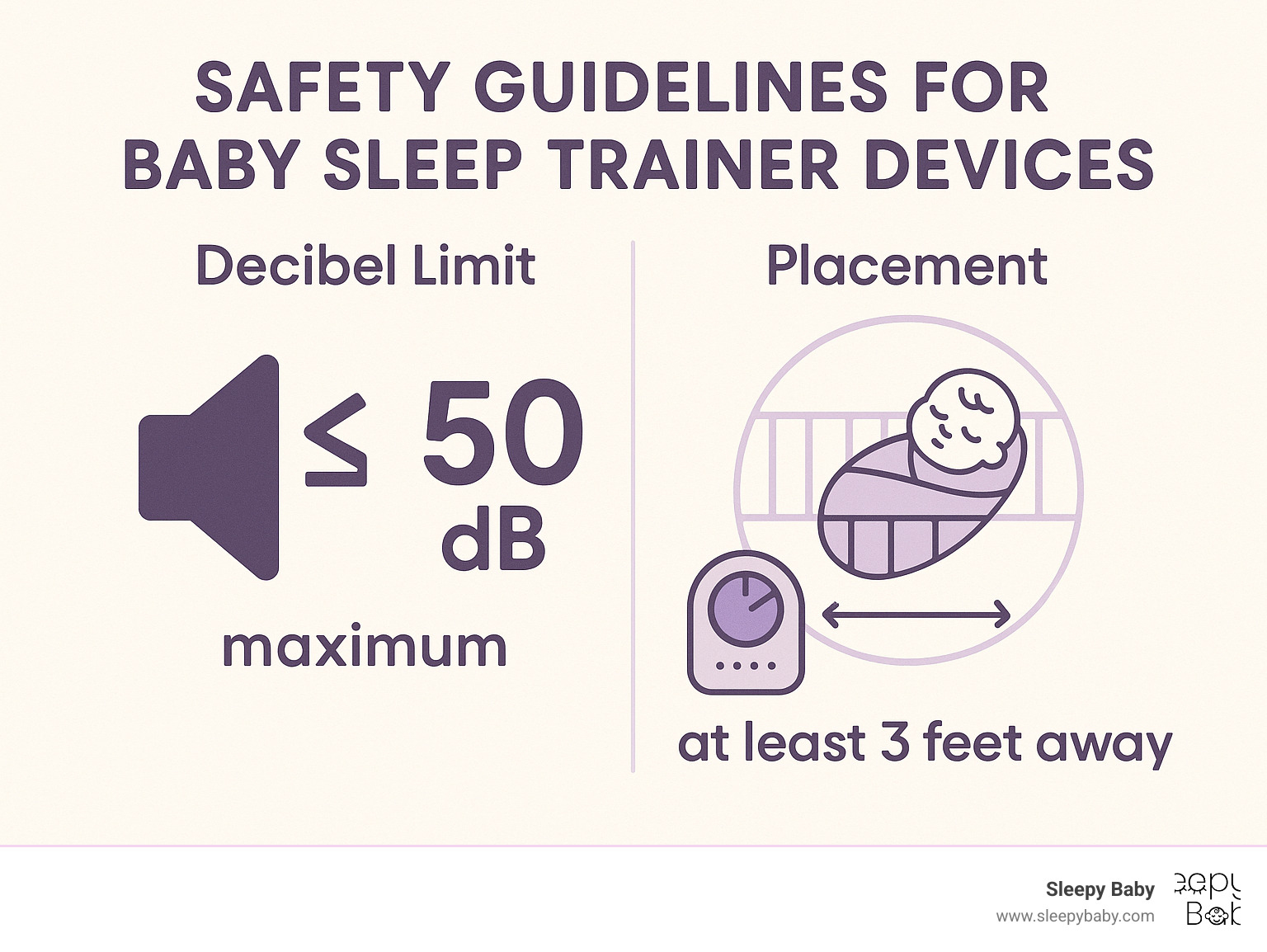
But here's where I need to pump the brakes on the enthusiasm. These devices aren't magic wands, and anyone selling them as such is doing you a disservice.
The dependency risk is real, though not necessarily problematic. Some babies become so used to their sleep sounds that they genuinely struggle without them. This isn't harmful to your child, but it can create practical challenges during power outages, when devices break, or when staying somewhere you can't use your usual setup.
More importantly, a baby sleep trainer device works best as part of a bigger picture. If your baby's sleep schedule is all over the place, if feeding issues are causing frequent wake-ups, or if there are underlying medical concerns, no device will solve those fundamental problems.
The individual variation among babies is also striking. I've seen families where one child thrives with white noise while their sibling finds it overstimulating. Some babies need the visual cues of colored lights, while others sleep better in complete darkness.
Safety Considerations in the Nursery
Following AAP safe sleep guidelines isn't optional when using any sleep device. The basics are straightforward but crucial.
Placement matters tremendously. Keep your device at least 3 feet away from your baby's sleep surface. This distance ensures safe volume levels and eliminates any risk from cords or small parts.
Volume control is critical - never exceed 50 decibels at your baby's ear level. Here's a simple test: download a decibel meter app on your phone and measure the sound level right where your baby's head will be during sleep.
Cord management might seem obvious, but it's worth emphasizing. All power cords must be completely out of reach. Wall-mounted devices or cord covers aren't just recommended - they're essential for safety.
Regular inspection of your device helps catch wear, damage, or loose parts before they become hazards. A quick monthly check takes two minutes and provides peace of mind.
When a Baby Sleep Trainer Device May NOT Help
Recognizing when sleep issues need different solutions can save you time, money, and frustration.
Hunger-related wakings are the most common reason devices don't work as expected. If your baby is genuinely hungry - especially in those first few months - all the white noise in the world won't help. Focus on ensuring adequate daytime feeding and consult your pediatrician about feeding patterns.
Medical issues like reflux, sleep apnea, or other health concerns require professional treatment. A device might provide some comfort, but it won't address the underlying problem causing sleep disruption.
Inconsistent routines undermine even the best devices. If bedtimes, nap schedules, and wake times vary dramatically from day to day, the environmental cues from your device lose their effectiveness. Consistency is what makes these tools work.
How to Introduce and Use a Baby Sleep Trainer Device Effectively
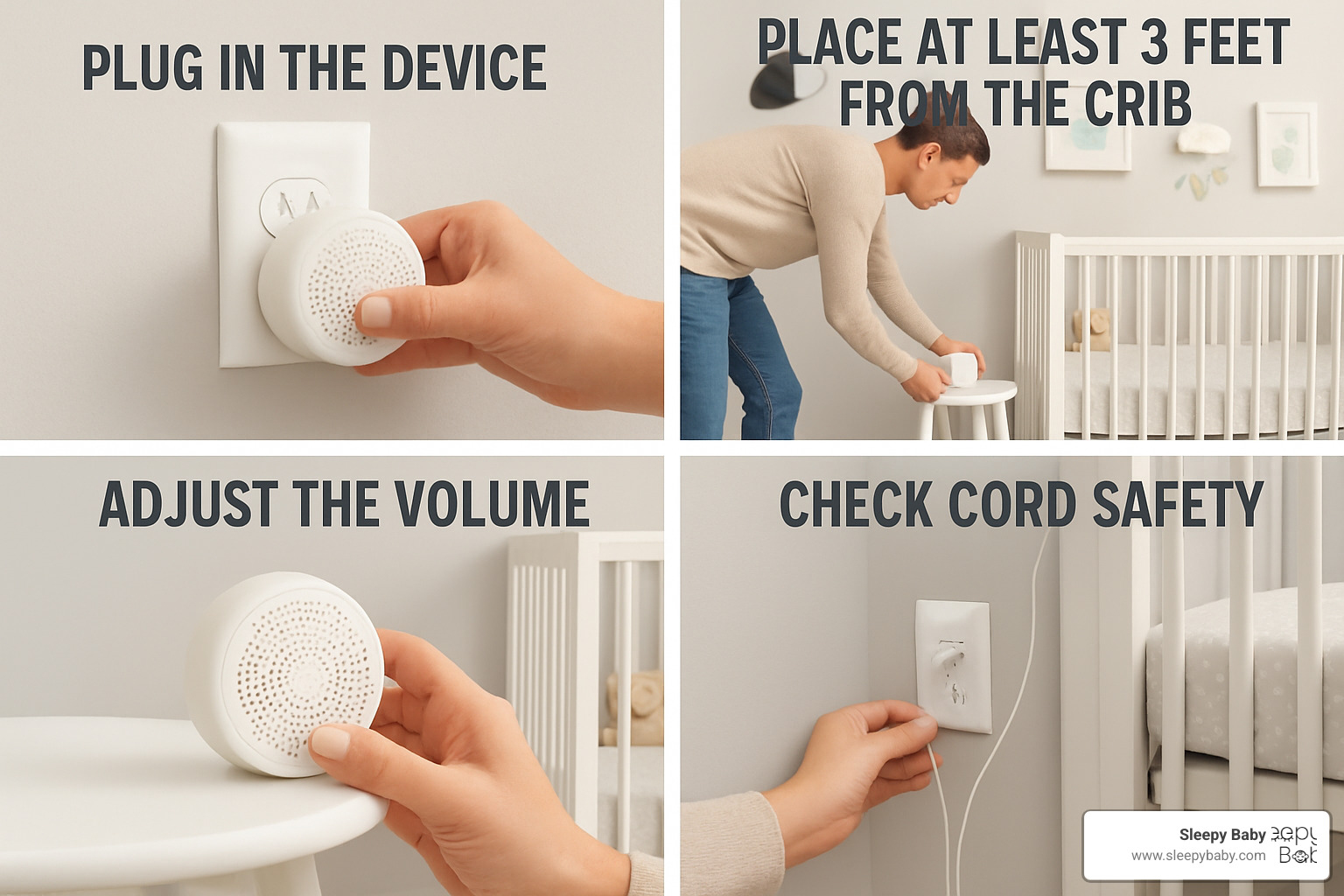
Success with any baby sleep trainer device depends largely on how you introduce and integrate it into your existing routines.
Routine Stacking: The most effective approach is to "stack" the device onto existing bedtime cues. If you already have a bath-bottle-book routine, add the device as the final step before placing your baby in their sleep space.
Gradual Introduction: Don't expect immediate results. Start by using the device during one sleep period (often the easiest nap of the day) for 3-5 days before expanding to all sleep times.
Positive Reinforcement: For older babies and toddlers, make the device introduction exciting. Let them help turn it on, choose colors (if applicable), or even give the device a special name.
Step-by-Step Plan with the Baby Sleep Trainer Device
Week 1: Daytime Introduction - Introduce the device during your baby's easiest nap time - Use moderate volume and gentle settings - Stay consistent with timing and placement
Week 2: Nighttime Integration - Add the device to bedtime routine - More info about rhythmic-patting - Monitor your baby's response and adjust settings as needed
Week 3: Full Implementation - Use for all sleep periods - Begin tracking sleep patterns to measure effectiveness - Make minor adjustments to volume, timing, or features
For Toddlers - The Stoplight System: If using a sleep trainer clock, introduce the concept during daytime play. Practice with stuffed animals or dolls, explaining that "red means sleep time" and "green means wake up time." Create a simple praise chart to celebrate successful nights.
On-the-Go Naps & Travel Hacks
Portable units shine when you need consistent sleep cues away from home:
Car Seat Mounting: Many devices include clips or straps for car seat attachment. This allows for consistent nap cues during long car rides.
Hotel Strategies: Combine your portable device with simple room darkening techniques. Pack lightweight blackout materials and use your device to create a familiar sleep environment anywhere.
Airplane Travel: Check airline policies, but most portable sound machines are allowed and can be invaluable for helping babies sleep during flights.
Frequently Asked Questions about Baby Sleep Trainer Devices
Let's address the most common questions parents ask when considering a baby sleep trainer device. These concerns come up in nearly every conversation I have with families exploring sleep solutions.
Do I need one if my baby already sleeps with a fan?
This is such a practical question, and honestly, if your fan is working well for your family, you might not need to change anything. There's wisdom in the old saying "if it ain't broke, don't fix it."
That said, there are some real differences between a regular fan and a purpose-built baby sleep trainer device. Fans can be inconsistent - their white noise changes when you adjust the speed for room temperature, and they're not designed with infant hearing in mind. Purpose-built devices offer consistent volume regardless of whether it's a hot summer night or a chilly winter evening.
Safety and flexibility are other considerations. Sleep devices are designed to be placed safely away from your baby's sleep area, while fans need to be positioned for air circulation. Plus, when you travel or move between rooms, a portable device travels with you, maintaining those familiar sleep cues wherever you go.
The bottom line? If your baby sleeps well with a fan and you're happy with the setup, stick with it. But if you're dealing with inconsistent sleep or planning to travel, a dedicated device might be worth considering.
Will the lights or sounds create long-term dependency?
I get this question from almost every parent, and it makes perfect sense. Nobody wants to create a situation where their child can't sleep without very specific conditions.
Here's the thing about healthy sleep associations - we all have them. Most adults rely on certain conditions to sleep well, whether it's a particular pillow, room temperature, or even the sound of a partner breathing nearby. These aren't problematic dependencies; they're normal comfort cues.
The key difference is flexibility. Problems arise when babies become so rigid in their sleep needs that they can't adapt to different situations. A child who can only sleep with one specific sound at one exact volume in one particular room? That's challenging for everyone.
Smart strategies can minimize dependency risk while still getting the benefits. Using timer functions instead of all-night operation helps babies learn to sleep through periods of quiet. Occasionally skipping the device - maybe during a weekend nap - ensures your baby maintains some flexibility.
Choose portable options that can travel with your family, and gradually reduce reliance as your child develops stronger independent sleep skills. The goal isn't to eliminate all sleep cues, but to create reasonable, manageable ones that support your family's lifestyle.
At what age can I switch from a sound-only unit to a clock-style baby sleep trainer device?
The magic window typically opens between 18 and 24 months, when toddlers develop the cognitive ability to understand visual cues and follow simple instructions like "stay in bed until the light turns green."
Watch for these readiness signs: your toddler can follow two-step instructions, shows interest in colors and basic concepts, and might be experiencing early morning wake-ups or bedtime resistance. The transition from crib to toddler bed is often a perfect time to introduce a clock-style device.
The transition works best when you layer new features onto familiar ones. Continue using the white noise or sounds your child already knows while gradually introducing the light cues. Practice the "stoplight system" during daytime play - make it fun by using stuffed animals to demonstrate how red means sleep time and green means wake up time.
Timing adjustments should happen gradually. If you're trying to shift wake-up time from 5:30 AM to 6:30 AM, move the green light in 15-minute increments every few days. This gradual approach helps your toddler's internal clock adjust naturally rather than fighting against sudden changes.
The beautiful thing about this transition is watching your child develop a sense of time and personal responsibility around sleep. Many parents find that toddlers actually enjoy having some control over their sleep routine through understanding these visual cues.
Conclusion
Here's the truth about baby sleep trainer devices: they're not magic wands, but they can absolutely be game-changers when you choose the right one and use it consistently.
The numbers speak for themselves. Over 200,000 families have finded better sleep with these devices, and the science backs up what exhausted parents have been experiencing firsthand. When babies have consistent sleep cues - whether it's gentle white noise, soothing red light, or rhythmic sounds - they develop stronger sleep associations and more independent sleep skills.
But let's be honest about what creates real success. A baby sleep trainer device works best when it's part of something bigger - what sleep experts call a healthy sleep ecosystem. This means combining your device with age-appropriate bedtimes, predictable routines, and a safe sleep environment that follows all the guidelines we know keep babies protected.
The device itself is just one piece of the puzzle. Your consistency matters more than any fancy feature. Your patience during the adjustment period matters more than the price tag. And your understanding of your unique baby's needs matters more than what worked for your friend's child.
Every family's journey looks different. Some babies respond immediately to white noise, while others need the gentle vibration of rhythmic patting. Some toddlers love the visual cues of a sleep trainer clock, while others do better with simple sound machines. There's no "wrong" choice - only what works for your specific situation.
At Sleepy Baby, we've watched thousands of families transform their nights. Our devices combine the soothing power of rhythmic patting with customizable sounds because we know babies crave that human touch, even when you need a break. We designed them to be portable because life doesn't stop for nap time. And we made them intelligent because every baby deserves personalized comfort.
The goal isn't just better sleep tonight - it's building healthy, independent sleep habits that grow with your child. When you find the right device and use it consistently, you're not creating dependency. You're teaching your baby that sleep is safe, predictable, and something they can do on their own.
That confidence benefits everyone. Your baby learns to self-soothe. You gain the parental confidence that comes from having a plan that works. And your whole family gets the rest that makes everything else possible.
You're not alone in this journey. Every parent has stood in a dark nursery at 3 AM wondering if they're doing everything right. The fact that you're researching solutions and trying to help your baby sleep better means you're already doing an amazing job.
More info about baby sleep solutions
Sweet dreams to you and your little one! Here's to nights filled with rest and mornings filled with smiles.


